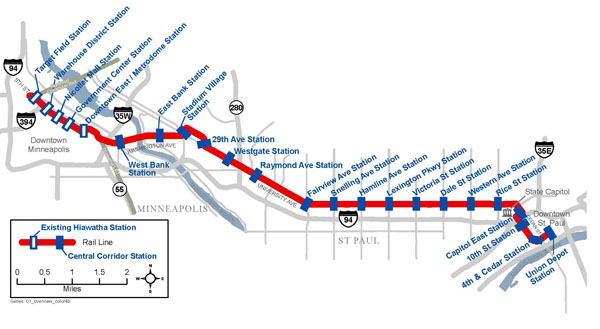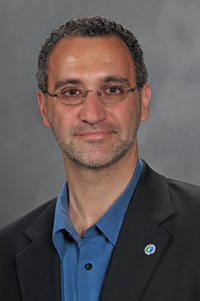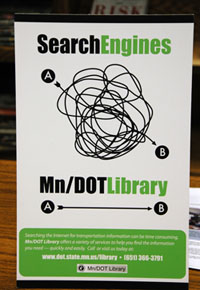 |
|

|
 |
TABLE of CONTENTS
 |
Districts respond to multiple pavement buckles across the state |
Hot temperatures caused several pavement buckles on highways throughout the state June 6 – 7, including 46 separate cases in Metro District alone.
Maintenance employees worked late into the night and early mornings June 6 – 8 to repair roads as quickly as possible and minimize traffic impacts. Buckles also occurred at eight locations in District 7, two sections of Hwy 56 in District 6 and one area on Hwy 53 in District 1.
|
|
 |
|

|
 |
TABLE of CONTENTS
 |
State launches contingency planning website |
Minnesota Management & Budget activated the state’s Be Ready website on June 3 as a resource for the public, state employees, government service stakeholders and members of the media about contingency plans in the event that there is a break in government service on July 1. The break will occur if a negotiated budget agreement is not signed into law.
The website offers a variety of information, including frequently asked questions, employee relations information and information for the media.
“The administration's highest priority remains negotiating a compromise budget agreement,” said MMB Commissioner Jim Schowalter. “However, in order to be responsible stewards of the state, we need to plan accordingly for all circumstances. This website is another tool for our employees and stakeholders to use to answer some of their questions. It is critical we provide clear and concise information to everyone.”
The website, www.bereadymn.com, will be updated as new information is released.
In addition, MnDOT has an internal website that archives all the e-mails and webcast that Commissioner Tom Sorel has provided to employees as well as communications and links from other sources. See http://ihub.dot.state.mn.us/shutdowninformation/. |
 |
|

|
 |
TABLE of CONTENTS
 |
I-35 Mega Project is off to ‘rocket start’ in year two |
|
By Bob Filipczak
The Interstate 35 Mega Project in Duluth, one of the biggest road construction undertakings in Minnesota, is progressing on schedule through its second year of work.
A combination of great planning, experienced contractors, a great MnDOT project team and hard work has kept the project on schedule this year, according to Pat Huston, District 1 resident construction engineer, who said he is very confident about the progress.
“I look at the Mega Project this year and I don’t think it’s so Mega,” Huston said. “Everything started faster because everything was fully mobilized and in place—everyone was familiar with the project. We really got off to a rocket start.”
Although crews have plenty of work to finish still in 2011, the project scope is much smaller this year, according to Huston. Construction work in 2010 stretched for 11 miles on I-35, while work this year will be limited to a three-mile stretch.
Improving safety
Safety, both in the work zones and in the long run, has greatly increased due to the nature of the project. This year, traffic is being shifted to pavement that was freshly installed last year so motorists have fewer distractions and a smoother ride. In addition, there was little room for stalled vehicles during last year’s construction, which could cause serious backups. This year, new wider shoulders are available to handle similar situations.
In the long term, I-35 in Duluth will be a much safer highway, according to Roberta Dwyer, project manager.
“Because we got the funding and were able to do this all at once, we were able to make some major safety improvements, including wider shoulders, improved sight distance, enhanced lighting and pavement markings,” Dwyer said.
Implementing innovative road surface
One of the more innovative aspects of the Mega Project is easier to hear than see. It’s called Next Generation Concrete Surface—District 1 included the experimental grinding on portions of the new concrete road surface.
Traditional concrete grinding cuts grooves into pavement surfaces to increase traction on wet and icy days, as well as improve the overall ride. NGCS is a new pattern of grooves that has the added benefit of reducing tire noise by as much as six decibels. The Mega Project was the first large-scale project in the nation to try the new pavement grinding technique.
For more information on the I-35 Mega Project in Duluth, visit www.dot.state.mn.us/duluthmegaproject/index.html. |
 |
|

|
 |
TABLE of CONTENTS
 |
Work progresses on Central Corridor light rail project in Twin Cities |
By Mary McFarland Brooks
More than 50 years after the last electric street car rumbled down University Avenue between St. Paul and Minneapolis, work is again underway to bring light rail transit to the heavily traveled corridor, with passenger service expected to begin in fall 2014.
The Central Corridor line is anticipated to carry 43,000 people per workday by 2030, with a travel time of 40 minutes between St. Paul’s Union Depot and Minneapolis’ Target Field Station.
“The demands on transportation systems in Minnesota today are enormous and will increase in the foreseeable future,” said Tim Henkel, Modal Planning and Program Management Division director. “Minnesota’s approach to these challenges must encompass more than just roads to move people and goods. The CCLRT is one component of the planned system needed to serve Minnesota’s transportation needs well into the future.”
Work on the CCLRT began more than a year ago with utility and other construction activity in downtown St. Paul; the Minneapolis portion of the transit line has had crews working since September 2010. In Minneapolis, the work has been concentrated in the westernmost three miles of the train corridor, which goes through the east and west bank of the University of Minnesota, over the Washington Avenue bridge to where the tracks meet the Hiawatha light rail line between the Metrodome and the Cedar-Riverside stations.
The Metropolitan Council is the receiver of the grant for the CCLRT and is working closely with Mn/DOT and seven other partners on the project.
The Central Corridor project office includes MnDOT’s Bryan Dodds serving as assistant project director and 17 other staff providing support in the areas of utilities, permits, right of way, environmental issues and construction.
Minnesota’s other light rail transit system is the 12-mile Hiawatha Line from downtown Minneapolis to the Mall of America. The line began service in 2004, and had a ridership of 10.5 million in 2010.
Along with these two corridors, plans are underway for other light rail projects including:
- The Southwest corridor connecting Minneapolis to Eden Prairie by way of Minnetonka, Edina, St. Louis Park and Hopkins.
- The Bottineau corridor connecting Minneapolis and North Minneapolis, Crystal, Robbinsdale, New Hope, Osseo, Brooklyn Park and Maple Grove.
For more information, visit www.metrocouncil.org/transportation/ccorridor/centralcorridor.asp or www.dot.state.mn.us/passengerrail/index.

The 11-mile Central Corridor line will run on University Avenue and Washington Avenue between downtown St. Paul and Minneapolis. It will include 18 new stations in addition to five stations shared with the Hiawatha line in downtown Minneapolis. |
|
 |
|

|
 |
TABLE of CONTENTS
 |
Amr Jabr appointed acting District 1 engineer |
|
By Lisa Yang

Amr Jabr begins his role as acting District 1 engineer on June 20. Photo by David Gonzalez |
Amr Jabr begins his role as acting District 1 engineer June 20, an assignment that will last six to nine months. He succeeds Mike Robinson who retires June 29.
Jabr started his career at MnDOT in June 1989 as a student intern at the old Transportation Management Center. After one year, he became a graduate engineer and did rotations in different offices within District 6-Rochester for six months.
Jabr moved to Metro District and became traffic signal operations engineer from 1991 to 1995. In 2003, he became the Metro District traffic engineer. For the past four years, he has served as Metro District’s Operations and Maintenance director.
Jabr also worked for nearly six years in the Geometric Design Unit in the Office of Technical Support as well as state design standards engineer at Central Office.
One of Jabr’s goals as acting District 1 engineer is to focus on how the district is going to deliver the Better Roads Program to northeast Minnesota.
“We’re going to receive a good amount of money and will need to deliver,” Jabr said about the program.
Jabr said he also will focus on the Hwy 53 relocation project and make sure quality maintenance services, including snow and ice, are provided.
“I look forward to being in District 1 and learning from the employees about how they provide their products and services,” he said. “Also, Duluth is a cool city, so I look forward to getting to know more about it rather than just visiting it.”
Starting June 20, Jabr can be reached at 218-725-2704. |
 |
|

|
 |
TABLE of CONTENTS
 |
Move to new training system begins July 1 |
By Lucy Kender, Office of Human Resources
All MnDOT employees and training representatives will switch to the new statewide Enterprise Learning Management system for training registration, records and other training resources beginning July 1. During earlier phases of the transition, the ELM system served as the registration platform for SWIFT training only.
“As with the introduction of any new system, you will see many changes,” said Patti Follmer, ELM system administrator, Office of Human Resources.
One big change with the new system is where to access training-related information – through the State of Minnesota Employee Self Service website. Online tutorials are available to learn how to navigate the site. The tutorials provide self-paced lessons for students—called “learners” in the new system—as well as for managers and supervisors.
“I recommend going through these lessons before you log in to Employee Self Service for your training needs, as the new system differs quite a bit from the current MnDOT Learning Center,” said Follmer. “Lesson 3 (Employee Self Service) provides an overview of using employee self service and the learning elements; and Lesson 6 (Manager Self Service) is particularly important for managers and supervisors to review.”
Employees should check with their training representative before they register for training. The transition to the new system will not change how work areas manage training registration, unless their local training representative announces changes.
Registration for most MnDOT e-learning classes will remain on the MnDOT Learning Center and employees will need to access the Student Center to register for them. However, to register for SWIFT e-learning classes, learners will use the new system.
“Even though the transition date fast approaches, if you haven’t yet done so, double-check your training history in the current system to ensure the appropriate classes are marked complete. You may also want to print a copy of your training transcript for your records,” added Follmer.
Check the iHUB Training Registration, Records and Resources website for further updates, information and training aids.
|
 |
|

|
 |
TABLE of CONTENTS
 |
Government communicators recognize MnDOT Library, Newsline |
By Libby Schultz

The MnDOT Library received a merit award in visual design from the Minnesota Association of Government Communicators for posters and banners it created to improve the look and layout of the library. Photo by Libby Schultz |
MnDOT's Library and the Office of Communications received recognition from the Minnesota Association of Government Communicators at its annual Northern Lights Awards Banquet May 24.
The MnDOT Library received a merit award in visual design for posters and banners it created to improve the look and layout of the library, highlight key services, incorporate new brand identity, and increase the visibility of the library.
The project included three tabletop signs, two easel posters, a large vinyl banner and a new logo, “Moving Knowledge.” The project also included new chairs, new desks, and re-designed shelving in the library.
“We want people to know our library exists,” said Karen Neinstadt, reference and outreach librarian. “It’s user friendly, and everybody is welcome.”
The Office of Communications received a merit award for Newsline, the department’s electronic employee newsletter. Published biweekly, Newsline features articles that inform employees about transportation news and other issues that affect their jobs.
“Communicating with employees is one of the most important things we do at MnDOT,” said Communications Director Kevin Gutknecht. “This award indicates that our work in this area is very good and very worthy.
“We know employees look to Newsline as an important source of agency information,” he added. “It’s good to know that other government professionals judge our efforts as exemplary.”
The Northern Lights contest recognizes outstanding work in government communications. The contest is open to public communicators, and producers in the private sector. This year, there were 140 contest entries in 13 categories; 68 received awards.
To learn more about MAGC and all of the 2010 winners, visit www.magconline.org/awards.html. |
 |
|

|
 |
TABLE of CONTENTS
 |
Old bridge finds new home |
On May 20, a 133-year-old bridge began its new life as part of the Gateway Trail spanning Manning Avenue near Stillwater.
The recently restored Silverdale Bridge, one of the oldest bridges in Minnesota, was originally built in 1877 in Sauk Centre. In 1937, the bridge was moved to a remote area near Silverdale where it served as the Hwy 65 crossing over the Little Fork River.
The 150-foot wrought iron bridge will become part of the Department of Natural Resource’s trail system. |
 |
|
| |
|



